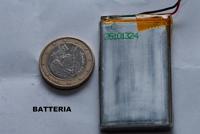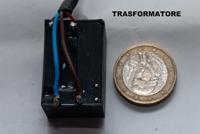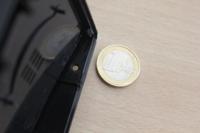A microphone was found in a house. The device was connected to the fridge electrical outlet. It included a microphone, two antennas and a SIM card.
A microphone was found in a house.
An audio surveillance device was found in an anarchist library. The device was hidden inside the printer-copier of the library. It included two microphones, an antenna, a transformer, a battery, a small box containing an electronic card, a 64 GB SD card, and a SIM card. According to the article that reported the discovery of the device, it was a surveillance device of model RB800 marketed by the Italian company Innova.
Analysis of the SD card revealed that :
- The device was equipped with a “voice activation” function, i.e. it only activated when its microphone picked up a sufficiently high sound level. In the month and a half prior to its discovery, it was activated 2,061 times, with a minimum activation duration of 58 seconds, a maximum duration of 12 hours and an average duration of 10 minutes.
- When the device was “activated” by the sound level, it transmitted data over the mobile phone network (presumably the audio data captured by its microphone), generally at a rate of a few KB/s, with peaks of 100 KB/s.
- The temperature of the device varied between 14°C and 50°C, with an average of 22°C. Its temperature rose sharply when it was transmitting data.
- RB800-en.pdf: product description of the RB800 device (in English).
- RB800-fr.pdf: product description of the RB800 device (in French).






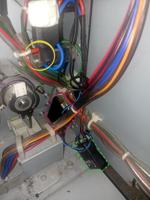



A camera was found in a residential building close to a social center, in a small locked room on the 12th floor, overlooking the social center's main entrance through a window. It was mounted on a tripod and powered by a socket in another locked room, through a cable laid outside across the roof. The residential building was located about 260 meters from the social center.






Several cameras were found in the attic of a public school located in front of a recently evicted squat, overlooking the squat through the skylights.
Three surveillance cameras were found in a building, pointed towards the entrance of a wagenplatz (a leftist political community where people live in trailers). They were located in a locked room, on the sixth floor of a building close to the wagenplatz — the building in question was vacant except for its first floor. One of the cameras was a “Sony ISO 409600 Extreme Sensitivity 4K” with a high-grade “Sony SEL 600mm F4 GM OSS E-mount” telephoto lens. The two other cameras were “Panasonic WV-S6131” IP cameras.
All three cameras were connected to a “G-ST 500+/8R Gscope055” video management device marketed by the German company Geutebrück, which was equipped with a SIM card and a 2 TB SSD. The SSD contained video files dated from November and December 2022 in the GBF (Geutebrück Backup File) format, which can only be opened with the company's proprietary software. There were three files per day, each of which could be assigned to a camera. The file sizes indicated long-term and continuous video surveillance.
Another drive located in the room (a “Samsung Portable SSD T5”) contained additional GBF video files dated from September and October 2022, as well as two images taken by the IP cameras dated from August 2022 and showing the entrance of the wagenplatz, people and vehicles.
The whole installation was powered from a wall socket using an “Antrax SwitchBox-GSM” device which contained another SIM card, seemingly allowing the installation to be powered on and off through the mobile phone network. The IP cameras were powered by the video management device through Ethernet (using a “Delock Gigabit PoE+ Splitter” device).

























A microphone was found in an apartment. It was hidden on the back of the kitchen oven. It was powered by the oven electrical supply, and was also equipped with a battery.
A microphone was found in a building. It was located inside a power outlet. It was equipped with a microphone, two antennas, a SIM card, a memory card and a battery.
Four microphones were found in a house. There was one in each room of the house. They were connected to the electrical system of the house using a transformer and a battery. Each device was equipped with a SIM card and a memory card.
According to the source that reported the discovery of the microphones, they were supplied by the Italian company Lutech.
Microphones were found in a building. They were connected to the electrical system of the building.
According to the article that reported the discovery of the microphones, they were supplied by the Italian company Lutech.
Microphones were found in a building. They were located in the kitchen.
Six microphones and a camera were found in a house. The microphones were located in electrical outlets and switch cases, one above the intercom in the corridor, two other in the living-room, and the three last ones in bedrooms. The camera was located inside the intercom in the corridor and connected to the microphone above it. Each microphone was equipped with a battery, and, except for the one in the corridor, with a SIM card and a memory card. The camera lens could observe through a small hole already present in the intercom structure and slightly modified to fit the device.
A microphone was found in a building. It was located in a multi-socket adapter. The device contained a printed circuit board and a battery. It was seemingly installed during a house search by police earlier in the month.
Two microphones were found in a house.
Several surveillance devices were installed from 2015 to April 2018 in the Ecuadorian embassy in London to surveil Julian Assange, founder of the news organization Wikileaks, which had taken refuge in the embassy since 2012. During this period of time:
- The interior cameras were replaced with higher resolution cameras equipped with hidden microphones.
- Microphones were hidden inside a fire extinguisher and above the storage cabinet in the bathroom used by Assange.
- Special stickers were attached on the exterior windows of the embassy to facilitate the use of a laser microphone (able to capture audio by detecting the sound vibrations in the windows) from a building nearby.
- A device capable of transmitting in real-time the information collected by the other devices was installed.
The microphone inside the fire extinguisher was equipped with an SD card and a battery which was changed every twelve hours. The microphone in the bathroom was connected to the electrical system of the building. The devices were installed by the Spanish company Undercover Global, officially in charge of the security at the embassy. Their installation appeared to have been ordered by the CIA (Central Intelligence Agency).


A listening device was found in the former home of an Irish republican, who had died ten years prior to the discovery of the device. It consisted of a small microphone, hidden in the ceiling of a downstairs room, along with a number of battery packs located under the floorboards of an upstairs bedroom.
Two microphones were found in a building. They were hidden inside a power outlet and in the junction box next to it.
A micro-camera was found in a house. It was located in the kitchen/dining room, inside a wall, covered up by mortar, revealing only the hole for the camera's lens.
A surveillance device was found in a building inside an outlet not connected to any electrical network. The acronym “ABG” was visible on one of its edges.
A microphone was found in a building. It was located inside a neon light attached to the ceiling. It consisted in three 9-volts batteries, joined together with insulating tape, with a microphone and antenna at each end.
Listening devices were found in a building. They were hidden in electric sockets.
A surveillance device was found in a school located in front of an anarchist library. It was located in a storage room on the first floor, overlooking the library through a window. It looked like a cardboard folder. It was contained in a hard plastic rectangular casing of about 40x25x25 centimeters. It was loud (because of fans) and connected to the electrical network (without batteries). The casing had a hole of about 4 centimeters in diameter for the camera, with three cables coming out at the end, two of which were antennas and a third a small square sensor.
Inside the box were:
- A wireless router with two SIM cards, a GPS module, three cell inputs, and one stereo input.
- A processor.
- A cellular device with a SIM card.
- A camera with two remote-controlled zoom levels.
- And other things that could not be identified.
The device was in place since at least the second week of July 2015.
- paris-2015-09.zip: additional pictures of the devices.
A listening device was found in the home of an Irish republican. It was built into a joist in a space between a ceiling and a bedroom floor. It contained several small listening devices that were connected to spotlights.
Two microphones were found in a home. The devices were inside two electrical outlets. Each consisted in a microphone connected to a transformer, and a thing containing a micro-SIM card.
A video surveillance device was found. It was located on the second floor of a vacant house. It contained cameras mounted on tripods, which filmed the public space through windows.
Two microphones and portable scanners were found in a building and outside of it. The portable scanners were in a telecom booth close to the building. The microphones were connected to the electrical network of the building.
A video surveillance device was found. It was located on the second floor of a vacant house. It contained a swiveling camera which was connected to a hard disk and could be controlled via an LTE mobile phone connection, and a battery to power the device. Through a window, the camera had a view of the sidewalk, several building entrances and several apartment windows. The device could not be seen from the outside as its luminous diodes had been masked off.
A police surveillance camera was found in a hospital, pointed towards another building.
Microphones were found in a building.
Four microphones were found in two homes. In the first home, a microphone was located next to the office where there was a computer (for some time, the loudspeakers connected to this computer were disrupted by an interference similar to the interference of a phone receiving a call), another in the outlet next to the kitchen table, and the last one in the bedroom, in the outlet closest to the bed (the outlet cover had been pierced to direct the microphone towards the headboard). In the second home, a microphone was located in the bedroom, in the outlet closest to the door leading to the kitchen, so that it covered several rooms. The first home's microphones included a transformer and antennas with a printed circuit board. The second home's microphone included two transformers and an antenna.
Two microphones were found in a building. They were located in the air vents of two rooms of the building. Each consisted in three 9-volt batteries set up in parallel, attached with tape to a transmitter microphone.


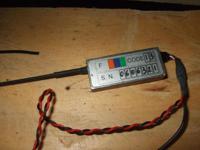
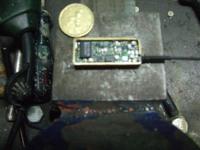

Four microphones and a camera were found in a house. A microphone was located behind the fridge, another in the bedroom, another in a beam next to the ceiling light, another in the house entry. A small camera filmed the entry stairs. All were connected through a transformer to the house electrical network.
A camera was found in a school's air conditioner. It controlled the entrance of a house.
A camera was found in an apartment. The device was located in the kitchen, behind a small air vent. It consisted in a camera connected to a large battery made of 3 tubes of 4 batteries of 14.4 V. The battery was behind the sink. Between the battery and the rest of the device was what seemed to be a switch that could be manipulated remotely. The camera was connected to a small black box that served as an encoder. This encoder, of model “Micro View Lock” (marketed by Ovations Systems), was in turn connected to what may have been an antenna to transmit images on a 1.4 GHz frequency. There was no SIM card. The camera, secured with magnets, was pointed towards the kitchen table.
Microphones and cameras were found in a building. A first device was located in an electrical case that was abnormally hot. It consisted of a microphone and a micro-camera. A second device was located in an industrial outlet.
A microphone was found in a building. It was located inside a closed and sealed electricity meter. It was a microphone with a 300 MHz shortwave transmitter.
Microphones and a micro-camera were found in multiple homes. The devices were found in an amplifier, in the kitchen hood and in a cathode-ray television. They included microphones and 300 MHz transmitters with ranges of 200 to 300 meters. One of the devices could be activated by remote control (at a distance of hundreds of meters). Another device came with a micro-camera linked to a UHF band transmitter.
A microphone was found in a building. It was located inside an electrical outlet. It was a transmitter-receiver.
A microphone was found in a building. It was located inside an electrical outlet.
A microphone was found in a home. It was hidden inside an air inlet. It consisted in 12 cylindrical batteries and a microphone.
A listening device was found in an apartment. It was located under the sofa. It was made of two meters of wiring with a microphone at the end. It was installed from the apartment below, through a hole in the floor.
Two receiver cases were found in the entry corridor of a building. They were hidden above a fake ceiling in the entry corridor. They were connected to the phone line with telephone wires. They consisted in a main unit with a remote-controlled connector, a digital receiver showing the strength of the received signal, and antennas. The presence of the two receivers presumably meant that there were two emitting microphones in the building.
A listening device was found in the home of an Irish republican. It was located in a cavity of the kitchen ceiling.
A listening device was found in offices used by Irish republicans. The device, disguised as a floor joist, was hidden under the floor of a first floor office with microphones pointing into the office and into a conference room below. It included a large battery pack.

















